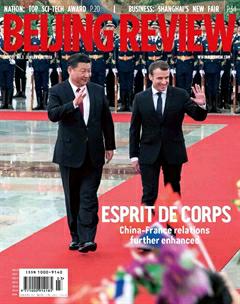Glassware on Fire
By+Wei+Yao
In 1962, 17-year-old Xing Lanxiang was hired by a glassware factory in Beijing after graduating from junior middle school. Before that, she had never heard of the art, and even afterward never did she expect to be engaged in it for the rest of her life. Today, together with her two sons, Xing is a national intangible cultural heritage inheritor and also the only glassware artist who has received the title of master.
In line with tradition, Xing followed a teacher, Tian Wenyuan, and after three yearsapprenticeship, she was already very good at the art thanks to her diligence and passion. She always chose to tackle complicated work and soon became a leading figure in the factory. When the factory established its technology department in 1979, she became a member and studied the technology and designed new glassware products together with masters.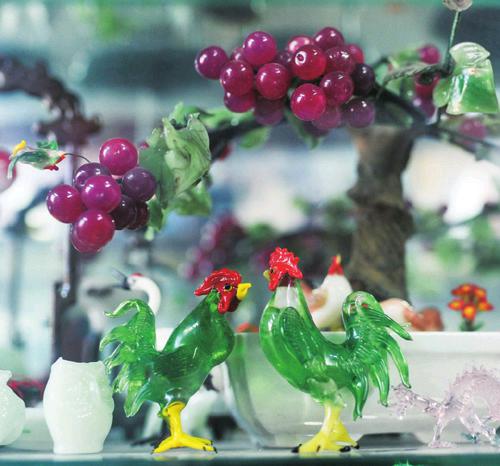
Making art with fire
Recalling the early days of learning to do the work, she still remembers the hardship.
“The working environment was terrible. We only had oil lamps, and we always had oil and dirt on our faces. In summer, as we did the job around stoves, it was so hot that we got heat rash,” she said.
Xing said that 26 young people were recruited by the glassware factory together with her, but eventually, only 10 stayed. She believed that those who managed to hold on were all really interested in glassware.
Still, this profession brought Xing a lot of pride, particularly during the heyday of her factory in the 1970s and 1980s, when the factory received a lot of foreign visitors every year. Glassware making is an art form that requires a product to be fi nished very quickly. Generally a product is completed within a dozen minutes, while complicated ones are done within half an hour or one hour. So this is a feat that is suitable to be watched by visitors. Foreign visitors tended to favor this kind of traditional task very much. Xing still remembers that Henry Kissinger, former U.S. Secretary of State, purchased a glassware dragon when vising the factory.
This memory f ills her with satisfaction. She said that at its peak, the factory had around 1,000 workers, and including the staff involved in the factorys outsourced work, there were around 3,000 people. However, this kind of prosperity began to wither and decline on the heels of the market economy. In 1992, plagued by market difficulties, the factory was closed. The majority of factory staff changed their jobs or chose to retire. A lot of old workers in love with the job shed tears at the sight. As a backbone of the business and also an inheritor of the art of making glassware, she was reluctant to leave the factory. Feeling sad at the demolition of her factory and selling off of equipment and tools, she tried to retain some tools then said goodbye to the factory and retired.endprint
In 1993, an American businessman opened a glassware company in Beijing and invited Xing to teach novices and design new products for the company. Unwilling to give up the craft, Xing decided to work in this foreign-funded enterprise. Xings retirement pay was only 200 yuan ($30.7) or so per month, but this company paid her 1,000 yuan ($154) as well as a yearend bonus of 10,000 yuan ($1,540), which she was very satisf ied with. The company was very successful, and it exported a huge amount of glassware products every year.
Xing was again confronted with a crossroads 10 years later. In 2003, encouraged by the government, the buildings of Xings old glassware factory were transformed into Baigongfang, a complex with hundreds of art workshops. Craftsmen of various sectors in Beijing were invited to set up their own studios there. Former leaders in Xings factory approached her in the hope that she would return,as no one else in Beijing was capable of running the glassware studio.
Although her American boss tried to persuade her to stay by increasing her salary, Xing finally decided to go to Baigongfang for two reasons: she hoped to repay the old factory for nurturing her, and she wanted to do more to help the inheritance of the art.
After moving to Baigongfang, her two sons also began to formally engage in the glassware sector. As they often played in their mothers factory when young, they had a good knowledge of glassware. It did not take long for them to settle in to the new occupation. Depending on the studio, the family began to forge its brand “Liaoqi Xing” or Xings Glassware Workshop. In order to succeed in the sector, they began to try some innovative ideas. Mainly, they produced tailor-made glassware to order. Whatever requirements customers had, whether expressed with photos, samples or just descriptions, Xing always did her utmost to make them satisfi ed.
According to Xing, the most diffi cult part of the glassware art is making figures, and what she prides herself on is her success in overcoming challenges in figure making in the past decades.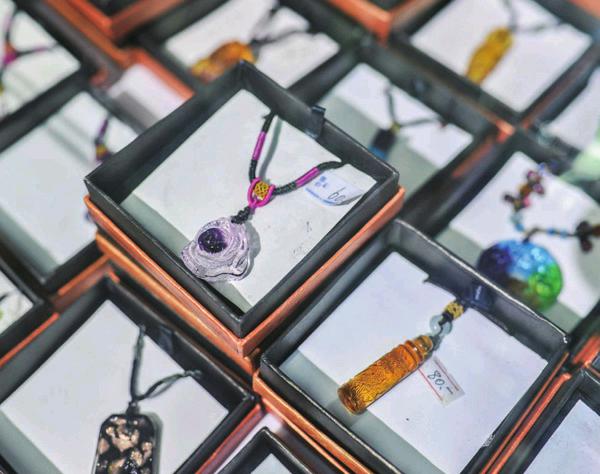
“Never has any product been returned. Customers are very satisfied,” said Xing. Her customers come from far and wide—elsewhere in China and even other countries. A lot of Japanese come to her for kimono ornaments because of the color and texture of the glassware she produces.endprint
“Glassware first emerged in the mid-17th century and began to thrive during the reign of Emperor Kangxi (1654-1722) of the Qing Dynasty. At that time, there was a special institution in the royal palace in charge of crafting glassware for the royal family,” Xing said.
At that time glassware products were exclusively made for the royal family and were forbidden to be made for the common people. Its bright and rich colors made glassware quite unique among the various handicrafts at that time, and it soon became widely favored when ordinary people were also allowed to have it. Glassware products made by handicraftsmen in Beijing are featured with royal styles.
Glassware can be divided into three categories in terms of shape. They are animals, plants and beads. Glassware fl owers look big and beautiful, but the skills required for making them are basic and simple, as they are just a combination of different pieces.
Struggling to continue
The theory of glassware making is easy to understand: materials are melted and cast into different shapes under high temperature, and when they cool down, the new products are ready. Glassware seems to be an easy art, but actually is very diffi cult to learn. The work must be done within a very short period of time, and it is hard to change the design once the material is cast into a certain shape. The production also has a high rate of failure. Thus, glassware making requires strong imagination and drawing ability as well as historical and cultural knowledge of other craftsmen.
The hardship of learning and grasping this skill makes its inheritance a major challenge. Xing once had more than 100 apprentices, but only one of them still remains in the sector, and thus she has only her two sons to pass the skill on to.
“Of course I hope the art of glassware can be handed down from one generation to another, as it is really beautiful and represents a high level of art,” Xing said.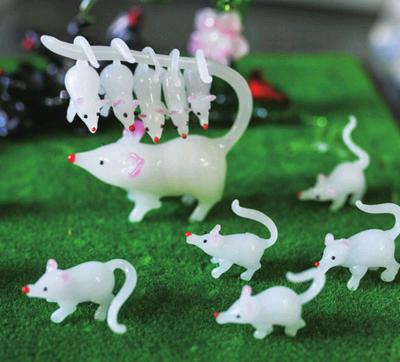
Xing appreciates the glassware industry in Venice very much and hopes that China can also do as well as Venice does in the glassware sector, particularly in its brand packaging of products. She believes that Beijings glassware technologies are as good as Venices, but its glassware industry has yet to be developed into a cultural tourism program. To realize this dream, the fi rst step is to sustain Chinas glassware art. No matter how unattainable this goal seems to be, Xing has never given up. Now she is working hard to promote glassware knowledge by giving relevant classes in schools or offering opportunities for students to experience the art. When conditions allow, students can even have a try at making glassware products.
Xing never misses any opportunity to spread glassware culture. Through various activities, more people have come to know about the art. In November 2017, she attended the 2017 Glass Innovation Design Contest in Hejian of north Chinas Hebei Province, where she exchanged views with masters in the sector. This further strengthened her confi dence in the art of making glassware.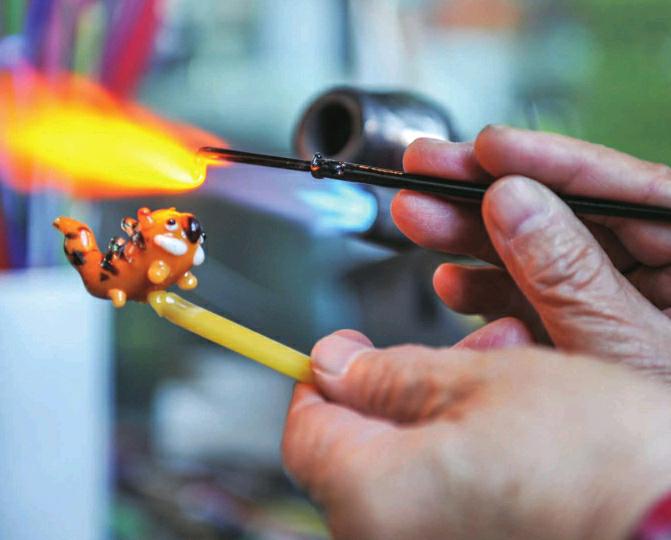 endprint
endprint

